
As the
Enlightenment ended, Paris was a busy place for science, and the city fostered
many famous scientists, including paleontologists and biologists. Inspired by
Buffon (September 7, 1707–April 16, 1788) and his
enormous 36 volume work Histoire naturelle, générale et
particulière (1749-1788 with 8 additional volumes
published posthumously by
Lacépède ), their contributions led the world with paleontologic and
biologic discoveries and contributions in the 18th and 19th
centuries. Their names are well known to biologists, paleontologists and
geologists–Lamark, Cuvier, Letreille, and St. Hillarie, among others. Streets
near the Muséum national d’Histoire naturelle , where most worked, bear
the names of the most
famous of these men, and the Jardin des Plantes
abounds with their statues and busts.
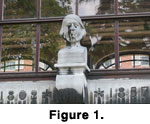 Among them, but perhaps not quite so well known in general nor
honored by a street name, but famous among paleontologists nevertheless, is
Alcide Dessalines d’Orbigny (September 6,1802–June 30, 1857), a
paleontologist and naturalist extrodinarie (Venec-Peyre 2002a).
His bust does grace the side of the Galerie de Paléontologie et
d’Anatomie Comparée, where he looks over the Jardin des Plantes and statues of
both Buffon and Lamark at opposite ends of the magnificent Allée Buffon (Figure
1).
Among them, but perhaps not quite so well known in general nor
honored by a street name, but famous among paleontologists nevertheless, is
Alcide Dessalines d’Orbigny (September 6,1802–June 30, 1857), a
paleontologist and naturalist extrodinarie (Venec-Peyre 2002a).
His bust does grace the side of the Galerie de Paléontologie et
d’Anatomie Comparée, where he looks over the Jardin des Plantes and statues of
both Buffon and Lamark at opposite ends of the magnificent Allée Buffon (Figure
1).
Alcide d’Orbigny did many things in his 55 years on
Earth. He started at an early age working with his father, a doctor, who had a
microscope. The two of them examined beach sand from the shores near La
Rochelle where they lived, and Alcide collected fossils from the region. This
started a life-long interest and passion for natural history that became
increasingly focused on paleontology. He worked in natural history, geology,
paleontology, anthropology, linguistics, and taxonomy and systematics,
publishing 310 monographs and papers and collecting thousands of specimens that
others studied (Heron-Allen, 1917). Few major phyla of animals were missed by
him, and he wrote on other topics, such as plants and foraminifera (Barta-Calmus
2002). His first paper was published in 1824 when he was just 22 (Figure 2)
and he continued his output throughout his short life.
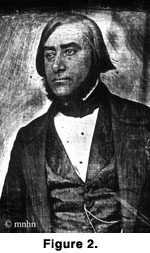 His
publication of descriptive material was incredible with thousands of species
described, many stratigraphic type sections located and described, the
occurrences of fossils documented chiefly in France, as well as his outstanding
Le Voyage dans l’Amérique méridionale in 11 volumes published between
1835-1847, and covering the biology, ethnology, anthropology, paleontology, and
other aspects of Chile, Peru, Argentina, Uruguay, and especially Bolivia. He
also received gifts of material from Columbia, Brazil and Cuba. Charles Darwin
admired these volumes as one of the most extraordinary works of science to that
date (Vénec-Peyré, 2002a). Indeed it was, in more than just a paper
publication. As with all his work, he brought his specimens, some 9330 of them,
back to Paris and deposited them in the collections of the Muséum national
d’Histoire naturelle, where they are still accessible to scientists today. Upon his return to Paris, he embarked not only on finishing his South American
work, but also in describing the fossils of France. Again, he produced enormous
works (Paléontologie française). Description
zoologique et géologique de tous les Animaux Mollusques et Rayonnés fossiles de
France in 43 volumes from 1840 to 1855, Prodrome
de Paléontologie stratigraphique universelle des Animaux Mollusques et Rayonnés
in three huge volumes, and the Cours élémentaire de paléontologie et de
géologie stratigraphiques. In these and many shorter papers, he
documented the fossils, their stratigraphic occurrences, inferred their
biogeography and established a scheme of 27 stratigraphic stages and “creations”
of new species. Creations was a unfortunate choice of words, for it led to the
mistaken idea that he was a creationist but he was rather interested in the
origination of new taxa as stratigraphic markers. He made no inference about
how these new species were “created” at each of his discontinuities (Fischer and Vénec-Peyré, 2002). “Appeared” may have been a better word, for that seems to
be what he meant. His work on fossils made France one of the paleontolgoically best known places, even today (Taquet and Vénec-Peyré, 2002). Napoleon III
created for him the Chair of Paleontology in the Muséum national d’Histoire
naturelle, a position he clearly earned but an appointment which was not
much appreciated by his colleagues. Unfortunately, this recognition came only
three years before his death in 1857.
His
publication of descriptive material was incredible with thousands of species
described, many stratigraphic type sections located and described, the
occurrences of fossils documented chiefly in France, as well as his outstanding
Le Voyage dans l’Amérique méridionale in 11 volumes published between
1835-1847, and covering the biology, ethnology, anthropology, paleontology, and
other aspects of Chile, Peru, Argentina, Uruguay, and especially Bolivia. He
also received gifts of material from Columbia, Brazil and Cuba. Charles Darwin
admired these volumes as one of the most extraordinary works of science to that
date (Vénec-Peyré, 2002a). Indeed it was, in more than just a paper
publication. As with all his work, he brought his specimens, some 9330 of them,
back to Paris and deposited them in the collections of the Muséum national
d’Histoire naturelle, where they are still accessible to scientists today. Upon his return to Paris, he embarked not only on finishing his South American
work, but also in describing the fossils of France. Again, he produced enormous
works (Paléontologie française). Description
zoologique et géologique de tous les Animaux Mollusques et Rayonnés fossiles de
France in 43 volumes from 1840 to 1855, Prodrome
de Paléontologie stratigraphique universelle des Animaux Mollusques et Rayonnés
in three huge volumes, and the Cours élémentaire de paléontologie et de
géologie stratigraphiques. In these and many shorter papers, he
documented the fossils, their stratigraphic occurrences, inferred their
biogeography and established a scheme of 27 stratigraphic stages and “creations”
of new species. Creations was a unfortunate choice of words, for it led to the
mistaken idea that he was a creationist but he was rather interested in the
origination of new taxa as stratigraphic markers. He made no inference about
how these new species were “created” at each of his discontinuities (Fischer and Vénec-Peyré, 2002). “Appeared” may have been a better word, for that seems to
be what he meant. His work on fossils made France one of the paleontolgoically best known places, even today (Taquet and Vénec-Peyré, 2002). Napoleon III
created for him the Chair of Paleontology in the Muséum national d’Histoire
naturelle, a position he clearly earned but an appointment which was not
much appreciated by his colleagues. Unfortunately, this recognition came only
three years before his death in 1857.
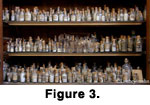 D’Orbigny made very large collections of fossils that
are now housed in the Galerie de Paléontologie et d’Anatomie Comparée, a
separate building with exhibits, research areas and specimen storage in the
Jardin des Plantes in SE Paris. D’Orbigny’s collection included more than
14,000 species and over 100,000 specimens not counting innumerable foraminifera
stored in assorted glass bottles (Figure 3). Many of them are kept in a special
room Salle d’Orbigny (Lauriat-Rage, 2002)
where they are available for study.
D’Orbigny made very large collections of fossils that
are now housed in the Galerie de Paléontologie et d’Anatomie Comparée, a
separate building with exhibits, research areas and specimen storage in the
Jardin des Plantes in SE Paris. D’Orbigny’s collection included more than
14,000 species and over 100,000 specimens not counting innumerable foraminifera
stored in assorted glass bottles (Figure 3). Many of them are kept in a special
room Salle d’Orbigny (Lauriat-Rage, 2002)
where they are available for study.
Foraminifera were first in Alcide d’Orbigny’s life. He learned about them when he helped his father back on those beaches at La
Rochelle to collect and observe sand. La Rochelle, a major port on the Atlantic
coast of France at the time, had visits by ships from all over the world. From
the sea captains, Alcide and his father also received material that they viewed
together with the father’s microscope. Young Alcide thus had opportunity to see
many foraminifera from a wide variety of places. He learned them well too for,
as a pre-teen and teenager, Alcide drew illustrations of foraminifera for his
father.
Although d’Orbigny’s paleontologic and biologic
contributions are immense and should be understood by all paleontologists
interested even just slightly in the history of their field, this review
concerns d’Orbigny’s first major scientific contribution, published
at the young age of 24 but actually started when he was 11 and working with his
father.
This work is the micropaleontologically-famous Tableau
méthodique de la classe des Céphalopodes (Vénec-Peyré, 2002b,
2004).
In this 59-page paper he established the order foraminifera, with five
families and 64 genera with 544 species distributed among them. Like others
before him, he considered the foraminifera to be miniature cephalopods, but he
easily accepted the later observations of his compatriot
Dujardin (1835a,
1835b)
that these were not higher animals at all but were single-celled organisms. The
publication illustrated few of the forms he described, although it was the basis
along with later publications on foraminifera for his title “The Father of
Micropaleontology” (LeCalvez, 1974) and
J.J. Galloway’s (1933) opinion that d’Orbigny was the “greatest student of foraminifera” of all time. Only 8 plates
of 31 species accompanied the paper. This led to much later speculation about
the proper assignment of taxa and, perhaps, to the English claim that he made
“species with reckless indifference to the innumerable inosculating forms”
(Williamson, 1858) and that such “simple organisms” could not possibly contain
so many genera and species (Carpenter, Parker and Jones, 1862), a view also
adopted by Darwin (1866).
Deshayes (1830), another French biologist, thought d’Orbigny’s classification “unnatural”, “vicious,” and “defective.” Had d’Orbigny been able to publish all the illustrations that he had so beautifully
prepared along with the text, his critics may have understood his enthusiasm,
and ultimately the correctness, of his judgments. But the Museum had planned an
expedition to South America and it invited young d’Orbigny to be the naturalist,
a position that he relished. He rushed to get ready for this voyage and he did
not properly finish his paper; it was published just before he departed for
South America. Nor did he publish his illustrations when he returned some seven
years later. Instead, he became increasingly involved with description of his
South American explorations, with other collections sent to him, and in
documenting the paleontology of France. The 45 missing plates were never
published. Workers ever since have tried to understand what he had based his
descriptions on, and several attempts at publishing the remaining 45 plates were
all failures.
Marie-Térèse Vénec-Peyré, the micropaleontologist at
the
Muséum national d’Histoire naturelle, who is charged with the care of the
d’Orbigny collection including the original illustrations d’Orbigny had prepared
for his first publication, has now completed the considerable job of publishing
the plates of the Tableau, 179 years later. Vénec-Peyré has produced a
wonderful book showing all missing plates of d’Orbigny in their original colors,
the way in which he went about making his plates, an updating of the taxonomy of
each species, comments on the existing d’Orbigny collection including the models
that he constructed of foraminifera, and along with various historical
descriptions. The book will certainly clarify many of the questions
foraminiferal workers have long had about d’Orbigny’s species.
Vénec-Peyré’s book is subtitled “the birth of
micropaleontology”, referring to the importance of the paper for later work. D’Orbigny’s work was used by later British (in spite of early criticisms by
Carpenter, Williamson, Parker and Jones, Brady used many of d’Orbigny’s names in
his description of the foraminifera of the Challenger Expedition), German,
Italian, and American micropaleontologists. Now d’Orbigny’s name appears in
most published faunal lists of foraminifera as the author of one or more species
therein. D’Orbigny went on to publish a total of seven large monographs on
foraminifera and he used them in a stratigraphic context, comparing the faunas
to others elsewhere.
The book also provides lessons in scientific
illustration that we have forgotten in the modern age of scanning electron
microscopes and digital imaging of various sorts. This in itself is well worth
looking at for d’Orbigny had achieved a high level of organization and technique
in developing his mostly unpublished plates. His illustrations were assembled
in fifty-seven “booklets,” one for each genus he considered and all the species
he assigned to it. From these, he produced his final plates. The booklets are
historical documents and excellent lessons in how to draw natural history
specimens, as well as valuable insights into what he observed about
foraminifera. Only two are include in this book of finished plates, but the
other 55 should be published in their entirety, perhaps right here in
Palaeontologica Electronica, for their historical and current biological
value.
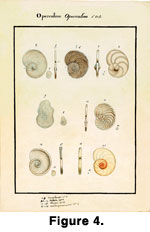 The plates in the book show interesting methods. Each set of drawing is framed in a thick line, labeled at the top above the line
with the generic name, and species names below the line at the bottom. Each
specimen was drawn at a much larger size, naturally, and to give the viewer a
correct impression, d’Orbigny also drew the specimen at natural size (Figure
4). Although most of these natural size drawings are merely dots, for the large
specimens they are tiny miniatures of the larger drawings (Figure 5). The most
interesting use of this latter technique is on plate 20 showing Rosalina,
a genus whose species attach themselves to shallow-water algae. On that plate,
then, d’Orbigny drew two algal fronds with small specks indicating the
foraminifera. These are then magnified to show the attachment in dorsal and
lateral views. Three other illustrations on the plate show a free specimen from
all sides. D’Orbigny was a careful observer and he wanted his readers to
appreciate the relationships of the foraminifera to their surroundings.
The plates in the book show interesting methods. Each set of drawing is framed in a thick line, labeled at the top above the line
with the generic name, and species names below the line at the bottom. Each
specimen was drawn at a much larger size, naturally, and to give the viewer a
correct impression, d’Orbigny also drew the specimen at natural size (Figure
4). Although most of these natural size drawings are merely dots, for the large
specimens they are tiny miniatures of the larger drawings (Figure 5). The most
interesting use of this latter technique is on plate 20 showing Rosalina,
a genus whose species attach themselves to shallow-water algae. On that plate,
then, d’Orbigny drew two algal fronds with small specks indicating the
foraminifera. These are then magnified to show the attachment in dorsal and
lateral views. Three other illustrations on the plate show a free specimen from
all sides. D’Orbigny was a careful observer and he wanted his readers to
appreciate the relationships of the foraminifera to their surroundings.
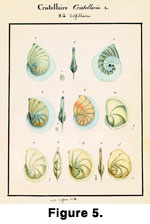 D’Orbigny was creative when it came to trying to get
other people to understand foraminifera. He knew that microscopic objects were
hard for viewers to visualize and that two-dimensional images of them may not be
so easy to understand, so he made models of 100 of his foraminiferal species
that could be handled and studied without a microscope. These were sold in four
sets of 25 each, and many made their way to other centers of study in Europe. They were used extensively by micropaleontologists to understand d’Orbigny’s
concepts of the species, and for teaching about foraminifera. This teaching
strategy is still commonly used in classrooms around the world where copies of
d’Orbigny’s models may be used.
D’Orbigny was creative when it came to trying to get
other people to understand foraminifera. He knew that microscopic objects were
hard for viewers to visualize and that two-dimensional images of them may not be
so easy to understand, so he made models of 100 of his foraminiferal species
that could be handled and studied without a microscope. These were sold in four
sets of 25 each, and many made their way to other centers of study in Europe. They were used extensively by micropaleontologists to understand d’Orbigny’s
concepts of the species, and for teaching about foraminifera. This teaching
strategy is still commonly used in classrooms around the world where copies of
d’Orbigny’s models may be used.
D’Orbigny left a huge scientific legacy in many
fields. This review merely points out that, if he is to be considered the
“father of micropaleontology”, then he must also be considered the father of
many other subdisciplines of both paleontology and biology. He established the
field of biostratigraphy, the concept of stratotypes, and correlation of similar
strata across Europe. His contributions to our field were enormous. All
paleontologists should revisit his work, if just briefly, to gain appreciation
of the remarkable achievements of d’Orbigny. This book therefore should be
studied as an example of the care that this early paleontologist took with his
work. Vénec-Peyré has done us all a service by assembling d’Orbigny’s first
plates and placing them and their author in historical perspective. The book is
beautiful, well assembled and organized itself, with text in both French and
English, and moderately priced. It should be in anyone’s library who is
interested in the history of paleontology or scientific illustration, to say
nothing of foraminifera.






